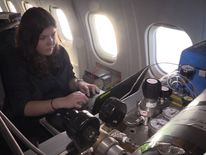Scientists fly high to tackle rising air pollution levels

Scientists have taken to the skies as part the most comprehensive ever assessment of Britain’s air pollution.
Researchers from the Natural Centre for Atmospheric Science are flying through the plume of pollution billowing from major cities to calculate exactly how many tonnes of sooty particulates and toxic gases are being emitted.
Sky News joined them for the first flight in a specially adapted aircraft to measure pollutants in a cross-section of the plume blown downwind of Manchester and Liverpool.
We flew at 230mph just 100ft above the Irish Sea, and then at progressively higher altitudes through the same column of air to build a profile of the invisible ‘cloud’.
Freya Squires, one of the team of scientists on board, said: “We have seen lots of pollution.
“We have got an easterly wind and we can see the pollution coming off Liverpool and Manchester.
“We have some big peaks in nitrogen oxide and nitrogen dioxide.”
The airborne laboratory is run by the Natural Environment Research Council (NERC). Hundreds of litres of air are sucked through pipes in the fuselage to banks of machines inside.
Computers generate real-time readings, allowing scientists to visualise the main pollutants.
They include particulates, which are particles of soot and other chemicals that are so small that they are inhaled deep into the lungs, and the toxic gas nitrogen dioxide, which irritates the lining of the lungs and can cause breathing problems.
Between 40,000 and 50,000 people a year die as a result of air pollution in the UK.
Globally, the World Health Organisation puts deaths from outdoor air pollution at three million, with 72% due to heart disease and strokes, and the rest due to lung disease and cancer.
Up to now scientists have monitored air pollution at street level and then attempted to estimate emissions for towns and cities.
But an airborne study by the atmospheric scientists found nitrogen dioxide levels downwind of London were 50% higher than had been estimated by computer models.
They believe dubious emissions figures claimed by car manufacturers are largely to blame.
Dr James Lee, the mission’s scientific lead, told Sky News that the accuracy of the airborne readings make the pollution generated by the aircraft worthwhile.
“We couldn’t do this any other way,” he said. “This is a real world measure of the amount of pollution. We need to know so that authorities can come up with strategies to make air quality better. There is no room for hiding.”
The UK is divided in 43 air quality zones, of which all but five breach EU pollution limits.
The Government is currently consulting on an Air Quality Plan that would create five ‘clean air zones’ outside London – Leeds, Nottingham, Derby, Birmingham and Southampton.
Liverpool and Manchester are not on the list, despite the level of pollution we witnessed on the research aircraft.
The plan is currently the subject of action in the High Court, with the lobbying group Client Earth warning it will not improve air quality fast enough.
The Government said in a statement it was “firmly committed to improving the UK’s air quality and cutting harmful emissions.
“That’s why we have committed more than £2bn since 2011 to increase the uptake of ultra-low emissions vehicles, support greener transport schemes and set out how we will improve air quality through a new programme of Clean Air Zones.”
[Source:- Skynews]

